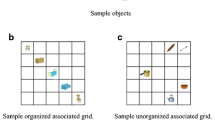Abstract
Background and aims: This study examined whether remembering location information relies on efficient inhibitory functions. Methods: In two experiments, younger and older adults performed an active visuo-spatial working memory (VSWM) span task. Participants were presented with a series of locations and asked to remember only final target locations, which were manipulated according to source (e.g., indicated by the experimenter or participant). Results: Data showed that, as the complexity of the VSWM task increased, older adults made more intrusion errors than younger adults, and that, older adults especially seemed to have difficulty in recalling correct locations when non-final locations were directly manipulated. Conclusions: This study highlights how older adults’ performance in VSWM is influenced by inhibitory working memory functions, which become particularly crucial as attentional demands grow.
Similar content being viewed by others
References
Cornoldi C, Vecchi T. Visuospatial Working Memory and Individual Differences. Hove: Psychology Press, 2003.
Copeland DE, Radvansky GA. Aging and integrating spatial mental models. Psychol Aging 2007; 22: 569–79.
Salthouse T. The aging of working memory. Neuropsychology 1994; 8: 535–43.
Maylor E, Vousden JI, Brown GA. Adult age differences in short-term memory for serial order: data and a model. Psychol Aging 1999; 14: 572–94.
Cornoldi C, Bassani C, Berto R, Mammarella N. Aging and the intrusion superiority effect in visuo-spatial working memory. Aging Neuropsychol Cogn 2007; 14: 1–21.
Vecchi T, Cornoldi C. Passive storage and active manipulation in visuo-spatial working memory: further evidence from the study of age differences. Eur J Cogn Psychol 1999; 11: 391–406.
Vanlierde A, Wanet-Defalque MC. Abilities and strategies of blind and sighted subjects in visuo-spatial imagery. Acta Psychol 2004; 116: 205–22.
Vecchi T, Richardson JTE, Cavallini E. Passive storage versus active processing in working memory: evidence from age-related variations in performance. Eur J Cogn Psychol 2005; 17: 521–39.
Hasher L, Zacks RT. Working memory, comprehension, and aging: a review and a new view. In Bower GH, ed. The Psychology of Learning and Motivation, Vol. 22: 193–225. San Diego, CA: Academic Press, 1988.
Hasher L, Zacks RT, May CP. Inhibitory control, circadian arousal and age. In Gopher D, ed. Attention and Performance XVII: Cognitive Regulation of Performance: Interaction of Theory and Application. Cambridge, MA: MIT Press, 1999.
Palladino P, De Beni R. Short term and working memory in aging: maintenance and suppression. Aging Clin Exp Res 1999; 11: 301–6.
Nigg JT. On inhibition/disinhibition in developmental psychopathology: Views from cognitive and personality psychology and working inhibition taxonomy. Psychol Bull 2000; 126: 220–46.
De Beni R, Palladino P, Pazzaglia F, Cornoldi C. Increases in intrusion errors and working memory deficit of poor comprehenders. Q J Exp Psychol: A 1998; 51: 305–20.
Passolunghi MC, Cornoldi C, De Liberto S. Working memory and intrusions of irrelevant information in a group of specific poor problem solvers. Mem Cogn 1999; 27: 779–90.
Daneman M, Carpenter PA. Individual differences in working memory and reading. J Verbal Learn Verbal Behav 1980; 19: 450–66.
Johnson MK, Raye L. Reality monitoring. Psychol Rev 1981; 88: 67–85.
Johnson MK, Hashtroudi S, Lindsay DS. Source monitoring. Psychol Bull 1993; 114: 3–38.
Henkel LA, Johnson MK, De Leonardis DM. Aging and source monitoring: cognitive processes and neuropsychological correlates. J Exp Psychol Gen 1998; 127: 251–68.
Mitchell KJ, Johnson MK, Raye CL, Mather M, D’Esposito M. Aging and reflective processes of working memory: binding and test load deficits. Psychol Aging 2000; 15: 527–41.
Glisky EL, Rubin SR, Davidson PSR. Source memory in older adults: an encoding or retrieval problem? J Exp Psychol Learn Mem Cogn 2001; 27: 1131–46.
Oberauer K. Binding and inhibition in working memory: individual and age differences in short-term recognition. J Exp Psychol Gen 2005; 134: 368–87.
Wechsler D, Wechsler Memory Scale-Revised manual. New York: Psychology Corporation, 1987.
Della Sala S, Gray C, Baddeley A, Allamano N, Wilson L. Pattern span: a tool for unwelding visuo-spatial memory. Neuropsychologia 1999; 37: 1189–99.
Spinnler H, Tognoni G. Standardizzazione e taratura italiana di test neuropsicologici. Ital J Neurol Sci 1987; 8: 1–120.
Cornoldi C, Mammarella N. Intrusion errors in visuo-spatial working memory performance. Memory 2006; 14: 176–88.
Lehman EB, Mellinger JC. Effects of aging on memory for presentation modality. Dev Psychol 1984; 20: 1210–7.
Goolkasian P, Foos PW. Presentation format and its effect on working memory. Mem Cogn 2002; 30: 1096–105.
Mammarella N, Fairfield B, Cornoldi C. Reality monitoring and resistance to forgetting under short retention interval. Q J Exp Psychol 2007; 60: 551–70.
Zacks RT, Hasher L, Li K. Human Memory. In Craik F, Salthouse T, eds. The Handbook of Aging and Cognition. London: LEA, 2000; 293–357.
Kausler DH. Learning and Memory in Normal Aging. San Diego, CA: Academic Press, 1994.
Chialfonte B, Johnson MK. Feature memory and binding in young and older adults. Mem Cogn 1996; 24: 403–16.
Baddeley AD. Is working memory still working? Eur Psychol 2002; 7: 85–7.
Author information
Authors and Affiliations
Corresponding author
Rights and permissions
About this article
Cite this article
Mammarella, N., Fairfield, B., De Beni, R. et al. Aging and intrusion errors in an active visuo-spatial working memory task. Aging Clin Exp Res 21, 282–291 (2009). https://doi.org/10.1007/BF03324917
Received:
Accepted:
Published:
Issue Date:
DOI: https://doi.org/10.1007/BF03324917




